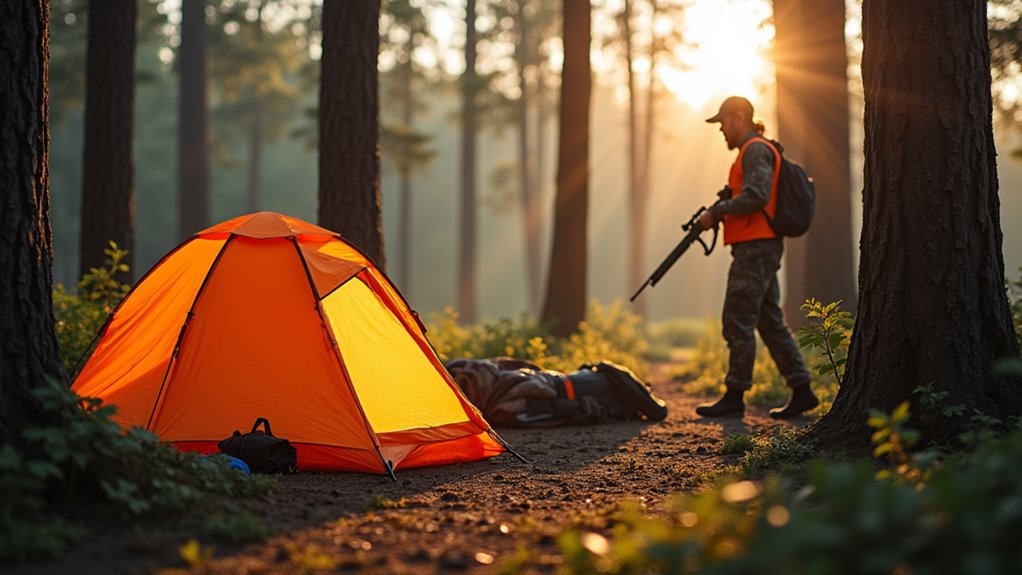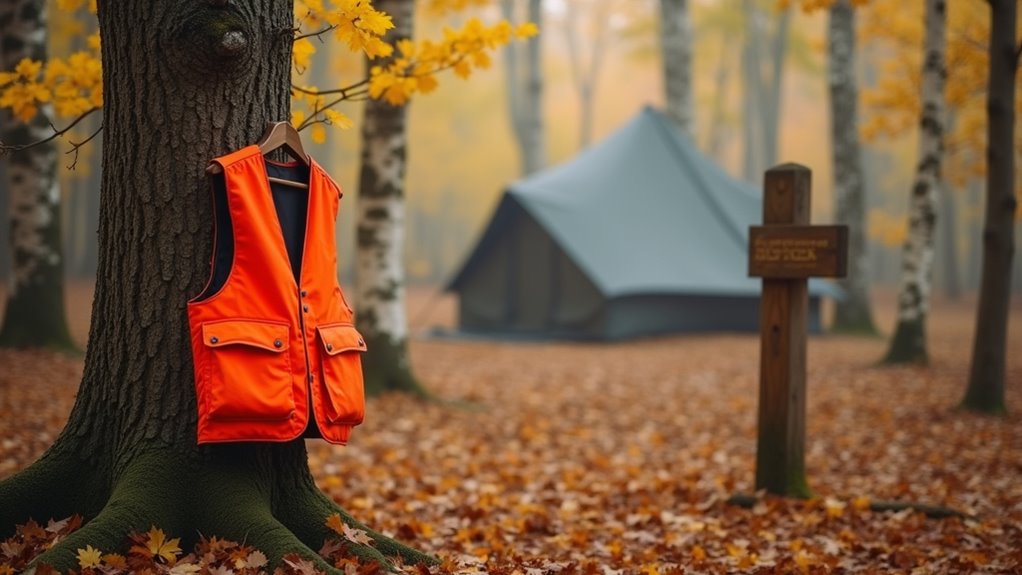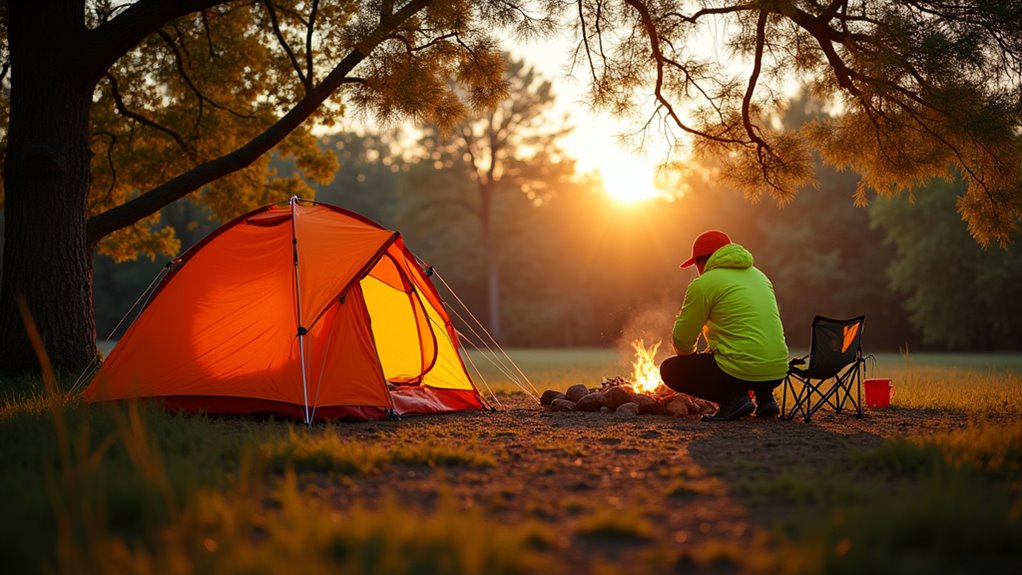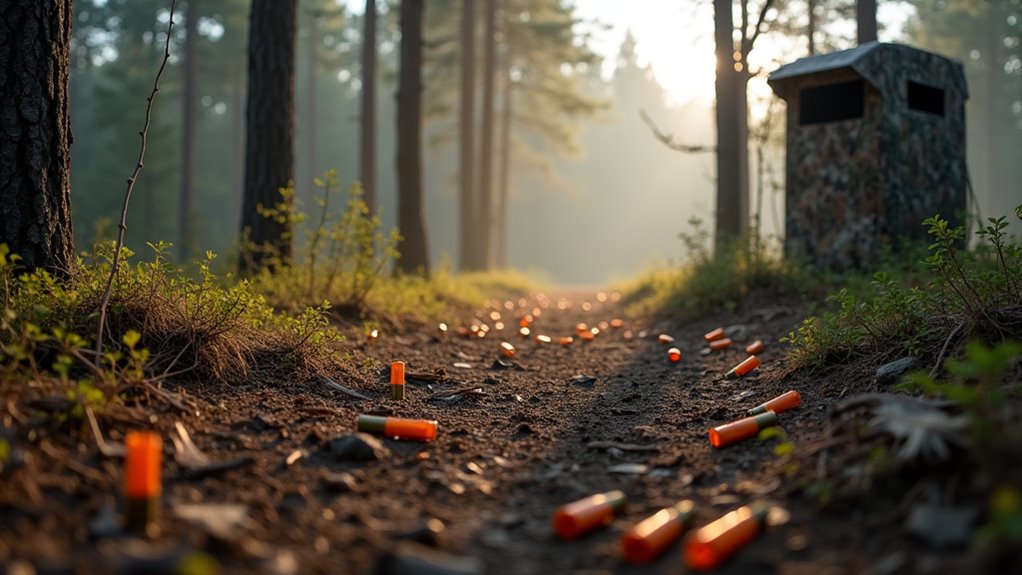Physical Address
304 North Cardinal St.
Dorchester Center, MA 02124
Physical Address
304 North Cardinal St.
Dorchester Center, MA 02124

Learn why autumn camping trips turn deadly when unsuspecting campers cross paths with hunters in shared wilderness areas.
You probably don’t realize that hunting accidents involving non-hunters spike during peak autumn camping season, when overlapping outdoor activities create dangerous blind spots. While you’re focused on setting up camp and enjoying nature, armed hunters might be tracking game through the same areas without knowing you’re there. The good news is that a few simple awareness strategies can dramatically reduce your risk and help you coexist safely with hunters who share these outdoor spaces.

Before you pack your gear and head out to your favorite camping spot, you’ll need to thoroughly research the hunting seasons and regulations for your specific area. Contact your state’s wildlife agency or visit their website to get current hunting dates, permitted game, and designated hunting zones. Don’t assume last year’s information is still accurate—seasons change annually.
Pay special attention to opening and closing dates for different types of hunting, including bow, rifle, and muzzleloader seasons. Some areas have split seasons with breaks between hunting periods. Check if your camping location falls within Wildlife Management Areas or public hunting grounds where restrictions may be stricter.
Download hunting season apps or print pocket guides to reference while camping. This preparation helps you avoid surprise encounters. Consider planning family camping activities that keep your group closer to designated camping areas during peak hunting times.
Once you’ve researched hunting seasons and regulations, you’ll need to strategically select camping spots that keep you away from high-traffic hunting areas. Choose established campgrounds over dispersed camping during peak hunting times, as these locations are typically off-limits to hunters and clearly marked.
Avoid camping near game trails, water sources, and feeding areas where wildlife congregates. These spots attract both animals and hunters.
Stay away from forest service roads that provide easy hunter access to remote areas.
Look for camping areas near residential zones or popular recreational spots where hunting isn’t permitted. State parks often prohibit hunting entirely, making them safer choices.
If you must camp in hunting areas, choose locations at least 500 yards from trails and maintain clear sight lines around your campsite.
Just as outdoor enthusiasts weigh the pros and cons of renting versus buying equipment for their adventures, consider whether a short-term camping reservation or purchasing your own camping gear makes sense for your safety and budget during hunting season.

While selecting the right location provides your foundation for safety, making yourself visible to hunters requires deliberate choices in both what you wear and how you set up camp.
Wear bright orange or fluorescent colors whenever you’re outside your tent. Hunter orange is your best choice since it’s specifically designed for visibility during hunting season.
Set up brightly colored tarps or flags around your campsite perimeter. Choose a tent in vibrant colors rather than earth tones that blend into surroundings. Hang reflective tape on nearby trees and bushes at eye level.
Your campsite should scream visibility with bright tarps, vibrant tents, and reflective tape positioned at hunters’ eye level.
Make noise during setup and throughout your stay. Talk loudly, play music at reasonable volumes, and use your vehicle horn periodically.
Light your campsite well after dark with lanterns and string lights to clearly mark your presence.
Consider using a jungle hammock instead of a ground tent, as elevated camping makes you more visible from multiple angles while keeping you safely off the forest floor.
Beyond visual signals, direct communication with hunters creates an immediate safety buffer around your campsite. Make noise regularly—talk loudly, play music, or clap your hands when moving around camp. Call out “Hello, camper here!” if you hear voices or movement nearby. Don’t whisper or try to stay quiet.
Carry a whistle and use three sharp blasts to signal your location. Air horns work even better for long-distance alerts.
If you spot hunters approaching, wave your arms and shout clearly: “Campers in this area!”
Most hunters appreciate the heads-up and will adjust their path accordingly. They’re typically safety-conscious and want to avoid accidents as much as you do. Clear, loud communication prevents dangerous surprises for everyone involved. Following proper camping etiquette ensures respectful coexistence between all outdoor enthusiasts sharing the wilderness.

Understanding when and how hunters operate helps you anticipate their presence and adjust your camping strategy accordingly. Hunters typically arrive before dawn and remain active until mid-morning, then resume activity from late afternoon until dusk. You’ll notice increased vehicle traffic on forest roads, especially trucks and ATVs carrying hunting equipment.
Listen for telltale sounds: gunshots, hunting calls, dogs barking, and conversations carried on the wind. Fresh tire tracks, game processing areas, and hunting blinds indicate recent activity. Hunters often scout locations days before hunting season, so don’t assume you’re alone during “off” periods.
Pay attention to hunting seasons in your area. Big game hunters behave differently than bird hunters—they’re quieter, move less frequently, and stay positioned longer. This knowledge helps you plan safer camping locations. If you need a quiet retreat from hunter activity, consider setting up camping hammocks in secluded areas away from main trails where you can rest comfortably between your location scouting efforts.
If you encounter armed hunters while camping, your immediate priority is ensuring everyone’s safety through calm, deliberate actions. Don’t make sudden movements that could startle hunters or be mistaken for wildlife.
Immediately announce your presence by calling out “Human here!” or “Camper!” in a clear, loud voice. Keep your hands visible and avoid wearing earth-tone colors that blend with natural surroundings.
If hunters seem unaware of your campsite’s location, calmly inform them you’re camping nearby. Most hunters will appreciate the heads-up and adjust their activities accordingly.
However, if you feel unsafe or notice reckless behavior, quietly evacuate the area and contact local authorities or park rangers. Always trust your instincts—it’s better to relocate your campsite than risk a dangerous encounter.
If you’re camping with dogs, keep them on leash and close to you, as loose pets can be mistaken for wildlife and create additional safety concerns.
You might think hunting season shouldn’t dictate your camping plans, but a few simple precautions can save your life. Picture yourself setting up camp in bright orange gear, hearing distant shots echoing through the forest—that’s your cue to stay extra vigilant. Don’t let fear keep you indoors; instead, arm yourself with knowledge about local seasons, wear visible colors, and choose established campgrounds. Your safety’s worth more than the perfect wilderness spot.